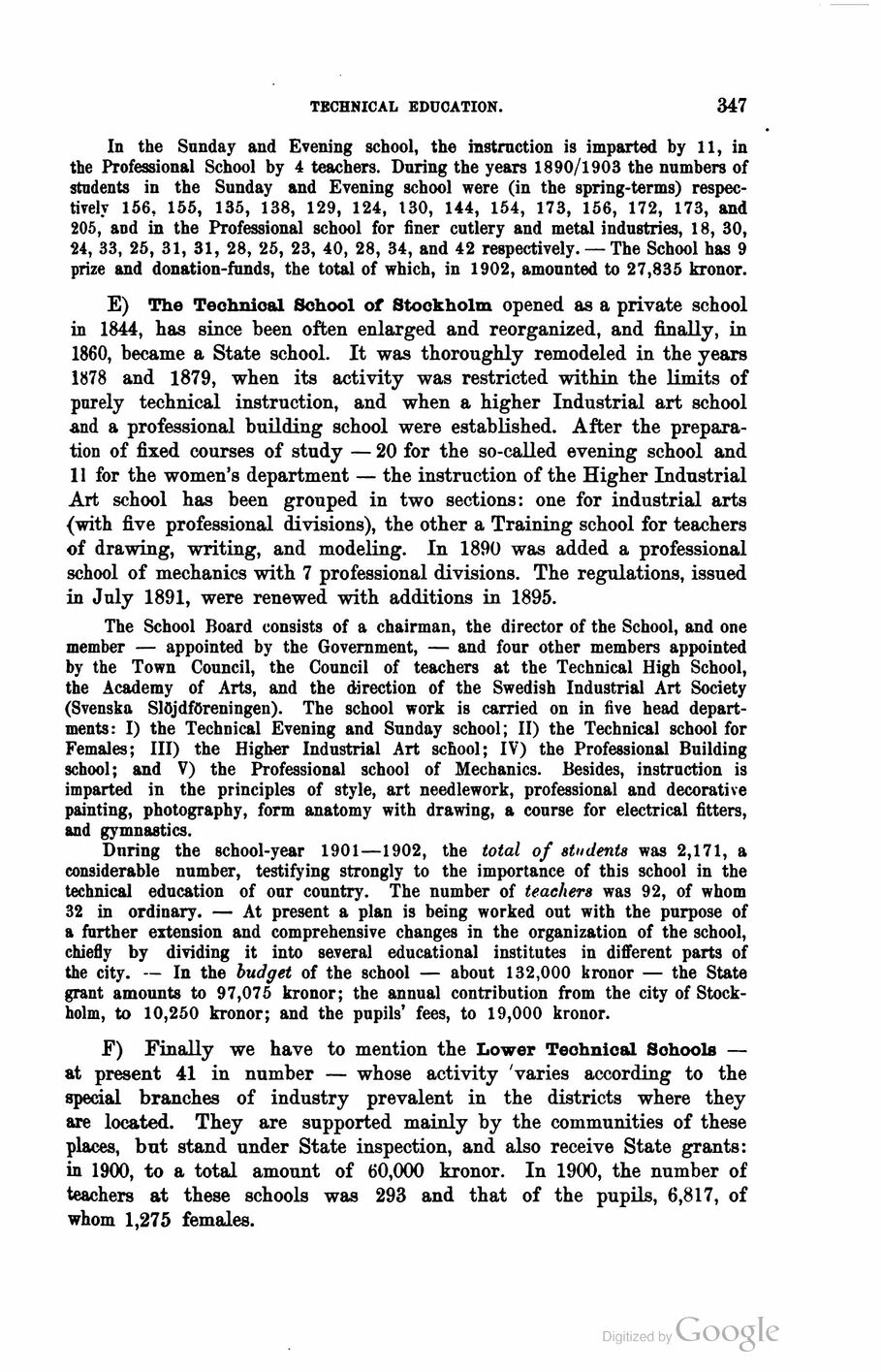
Full resolution (JPEG) - On this page / på denna sida - First part - IV. Education and Mental Culture - 4. Technical Education. By Lector A. Söderblom, Ph. D., Chalmers' Polytechnical College, Gothenburg - D) The Technical School of Eskilstuna - E) The Technical School of Stockholm - F) Lower Technical Schools

<< prev. page << föreg. sida << >> nästa sida >> next page >>
Below is the raw OCR text
from the above scanned image.
Do you see an error? Proofread the page now!
Här nedan syns maskintolkade texten från faksimilbilden ovan.
Ser du något fel? Korrekturläs sidan nu!
This page has never been proofread. / Denna sida har aldrig korrekturlästs.
TECHNICAL EDUCATION.
347
In the Sunday and Evening school, the instruction is imparted by 11, in
the Professional School by 4 teachers. During the years 1890/1903 the numbers of
students in the Sunday and Evening school were (in the spring-terms)
respectively 156, 155, 135, 138, 129, 124, 130, 144, 154, 173, 156, 172, 173, and
205, and in the Professional school for finer cutlery and metal industries, 18, 30,
24, 33, 25, 31, 31, 28, 25, 23, 40, 28, 34, and 42 respectively. — The School has 9
prize and donation-funds, the total of which, in 1902, amounted to 27,835 kronor.
E) The Technical School of Stockholm opened as a private school
in 1844, has since been often enlarged and reorganized, and finally, in
1860, became a State school. It was thoroughly remodeled in the years
1878 and 1879, when its activity was restricted within the limits of
purely technical instruction, and when a higher Industrial art school
and a professional building school were established. After the
preparation of fixed courses of study — 20 for the so-called evening school and
11 for the women’s department — the instruction of the Higher Industrial
Art school has been grouped in two sections: one for industrial arts
{with five professional divisions), the other a Training school for teachers
of drawing, writing, and modeling. In 1890 was added a professional
school of mechanics with 7 professional divisions. The regulations, issued
in July 1891, were renewed with additions in 1895.
The School Board consists of a chairman, the director of the School, and one
member — appointed by the Government, — and four other members appointed
by the Town Council, the Council of teachers at the Technical High School,
the Academy of Arts, and the direction of the Swedish Industrial Art Society
(Svenska Slöjdföreningen). The school work is carried on in five head
departments: I) the Technical Evening and Sunday school; II) the Technical school for
Females; III) the Higher Industrial Art school; IV) the Professional Building
school; and V) the Professional school of Mechanics. Besides, instruction is
imparted in the principles of style, art needlework, professional and decorative
painting, photography, form anatomy with drawing, a course for electrical fitters,
and gymnastics.
During the school-year 1901—1902, the total of students was 2,171, a
considerable number, testifying strongly to the importance of this school in the
technical education of our country. The number of teachers was 92, of whom
32 in ordinary. — At present a plan is being worked out with the purpose of
a further extension and comprehensive changes in the organization of the school,
chiefly by dividing it into several educational institutes in different parts of
the city. — In the budget of the school — about 132,000 kronor — the State
grant amounts to 97,075 kronor; the annual contribution from the city of
Stockholm, to 10,250 kronor; and the pupils’ fees, to 19,000 kronor.
F) Finally we have to mention the Lower Technical Sohools —
at present 41 in number — whose activity ’varies according to the
special branches of industry prevalent in the districts where they
are located. They are supported mainly by the communities of these
places, bnt stand under State inspection, and also receive State grants:
in 1900, to a total amount of 60,000 kronor. In 1900, the number of
teachers at these schools was 293 and that of the pupils, 6,817, of
whom 1,275 females.
<< prev. page << föreg. sida << >> nästa sida >> next page >>